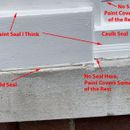Sealing Exterior Window Trim
Last year all IGUs in a bow window were replaced and the large pieces of trim around the whole window were stripped of paint or replaced (wide trim to each side is a false column, see attached “True Divided Lite Window”). Some joints were sealed with sealant, others with paint (is that even considered sealing?), and some weren’t (see the attachments showing the bottom of the “columns” and showing the trim stack-up under the IGUs. In another thread some of us are close to determining how to seal or seal and drain the glazing pockets. Please help me here to know which joints of the big trim surrounding the window should be sealed with what.
I see trim on or next to trim (a continuous flat face) with the crack between them; trim with trim behind or above it – the crack is at the 90; and trim on concrete. These close-ups showing old caulk etc. are after the rehab, which is why I ask you, not my contractor to please choose from the multiple choice (or add your own)…
The crack between two pieces of trim forming a continuous face should be… (left open, painted over, sealed with ____).
The crack between trim forming a 90 with trim in back of it or above it should be… (left open, painted over, sealed with ____).
Trim to concrete should be… (left open, painted over, sealed with ____).
Thank you,
GBA Detail Library
A collection of one thousand construction details organized by climate and house part












Replies
Contractor is arriving around 1:00 CST today - I could use some help understanding if the various external trim joint types he left unsealed actually do represent best practices or if I should ask him to seal them.
Although your contractor has come and gone, I'm giving your post a bump. Can you provide an update?
Thanks Kiley,
The question still pertains given he showed, applied something to the largest gaps, said he "has a plan" to seal the whole window against water, and apparently will call me to review it. So, if I can learn the answers to my questions I'll know what to say when we do talk. To all, I now know the rehab should have included drainage/weeping but seeing it's done we're focused on simply reducing water ingress.
I know large 90s from trim to trim and trim to concrete sill should be sealed (though with what for longevity?). But, joints in flat faces formed by stacking trim, and very small 90s (see Seal Cracks or Not) - should they be sealed with a sealant? I really don't know if so little water sits on these that just painting over them like my contractor did is OK or if even the small amount of water that could get in via capillary action after the paint chips is worth sealing out with a flexible, long-lasting seal.